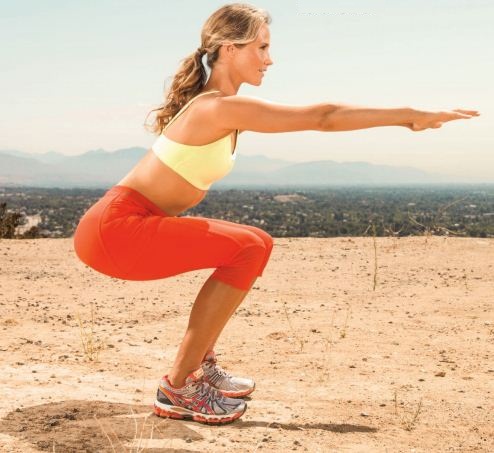With nearly half a million people finishing a U.S. marathon
last year, it might seem like you’re not a real athlete unless you’ve done a
26.2-miler. But new research suggests that the physical stress of long-distance
races may damage your heart over time by creating scar tissue that ups the risk
of irregular heartbeats. While the study is ongoing, there are other reasons to
stick to a shorter distance: You may have a lower risk of injury, it doesn’t
take as much time to train, and there are far more race options available.
So rather than pinning your hat on a marathon, go for speed
instead. Faster workouts, like sprint intervals and tempo running (or race-
walking), rev your metabolism and target extra fab around your waistline. Bonus
bragging rights: If you can break 60 minutes in a 10K race, you’ll be faster
than nearly half of the female racers out there.
The goal: Do a perfect squat
Short on time? Sculpt your entire lower body in a minute
with this move. “The squat engages the Lower back, abs, glutes, quads,
hamstrings, calves, and shins,” says Michele Olson, Ph.D., an exercise
physiologist at Auburn University in Montgomery, AL.
“It’s as close to ‘one exercise that gets all’ as they
come.” And because the squat is a functional move you use multiple times a day
(whenever you bend down to pick up something), performing it properly makes you
less prone to injuries.

Sculpt your entire
lower body in a minute with this move. “
To do it right, stand with your feet slightly wider than
your shoulders and extend your arms at chest height in front of you (or place
your hands on your hips). Squeeze your butt as you push your hips back and bend
your knees (imagine you’re sitting down in a chair). Lower until your thighs
are parallel to the ground [shown, below] or your back arches or rounds. Keep
your weight on your heels-try wiggling your toes to make sure it is. Too
challenging? Squat with your back pressed against a wall until you work up the
hamstring flexibility for the free standing version.
The goal: Climb a mountain
For this year’s vacay, skip the cruise and head for the
hills instead.
Alpine hiking (climbing at high altitudes) offers big-time
rewards. By the time you reach 14,000 feet, your body is working on 40 percent
less oxygenthan at sea level, which forces your muscles to produce new red
blood cells and operate more efficiently. It’s a tough fitness challenge, and
one of the reasons why many Olympic athletes live and train at high altitudes.
But us regular folks can benefit too. Austrian researchers found that over the
course of a three-week hiking vacation, people lost an average of 7 pounds of
fat. And it’s not just about the up hills, says study author Wolfgang
Schobersberger, Ph.D. Research suggests that eccentric exercise (like
descending a mountain) works your muscles in a unique way, upping your calorie
burn while improving your coordination and flexibility. Want to conquer your
first big climb? Book a trip to Denver and take on Mount Bierstadt, Grays Peak,
or Torreys Peak-acclimating to the “mile-high” city for a few days may make the
ascent to thinner air a little easier.

For this year’s
vacay, skip the cruise and head for the hills instead.
The goal: Master the hundred
“This pilates sculptor activates the transverse
abdominis-the deep abdominal muscle that pulls your belly in like a corset-15
percent more than a crunch,” says Olson. Add the bent-knee variation to your
routine stat, working up to the extended-leg version.
How to do it
Lie face up with your knees bent over your hips, shins
parallel to the ground. Extend your arms at your sides, palms facedown. Inhale,
then exhale as you lift your head, shoulders, and arms [shown, top left]; look
at your belly or thighs. Inhale as you pulse your arms up and down 5 times,
then exhale and pulse for another 5 counts. Repeat, working up to 10 full
breaths for a total of 100 pulses. As you get stronger, extend your legs at a
45-degree angle [shown, bottom left].You’ve perfected this move when you can do
100 pulses with your legs extended.

Master the hundred.
The goal: Defend yourself against an attacker
Just knowing how to fend off an assault will make you feel
stronger and safer, according to a University of Oregon study. To get the
skills you need, take a self-defense class or at the very least master a basic
knee-to-groin strike [shown, above]. “This move sends the other person’s head
forward and hips back, weakening his stance,” says personal trainer and
third-degree black belt Jennifer Cassetta, creator of the DVD set Stilettos and
Self-Defense.

Defend yourself
against an attacker.
How to do it
Grab one of your attacker’s shoulders or his shirt and
forcefully raise your knee toward his groin as you pull him toward you. Poke
him in the eyes or elbow him in the face, and run away as fast as you can.